Control system equipment
The control system equipment in a substation is a vital part that supervises, protects and controls the transmission of electrical power. The increasing complexity in the substations of today, together with the increasing transmitted power and the increasing fault current levels, means increasing requirement set on the control and protection equipment.

Dependent of the stations location in the networks and the power consumption, the operation and maintenance organization of the customer and government regulations etc., many choices must be done in order to achieve lowest possible Life Cycle Cost (LCC). The highest possible service reliability is a general goal. Flexibility and maintainability are also important factors in order to attain a total reliability.
The first choices are the selection of the primary apparatus. The choice of AIS or GIS switchgear and decision of the switchgear arrangement, to be used and transformer sizes etc. are important in order to achieve a low LCC. Thereafter choices of control and protection equipment must be done e.g. digital control equipment, single or redundant protection systems, design and voltage of battery system, choice of battery type etc.
It’s always difficult to foresee the future but a summary of expected changes of the power network in the area of the new station should always be done e.g. by checking plans for building of new living areas, starting of new industries etc., with the communities.
In this technical article a survey of different parts of the control and protection equipment is done. Equipment included in the control system are auxiliary power systems, protection system, metering equipment, control and regulation, signalling and event recording, and operation.
1. Instrument Transformers
1.1 Current Transformers
1.1.1 Location
The location of the current transformers will give the limitation of the protection zones. The most common approach is to locate the current transformer at the outside of the object circuit breaker, so that a Busbar differential protection will cover the circuit breaker.
The location should generally be as close as possible to the circuit breaker as the breaker will open when a fault is detected. The zones where an incorrect tripping is achieved is thereby minimized.
For GIS switchgears a requirement to cover all GIS compartment from the busbar protection is often raised. This will ensure an instantaneous trip for all faults in the GIS and the risk of “burn-through” is thereby minimized.
When Transfer busbars, C-arrangements, are used a location of current transformers outside the C-disconnector is preferred. The object protection will then still be in operation when the transfer busbar and transfer breaker is used to by pass another breaker scheduled for maintenance and a rearrangement of the trip circuit to the transfer breaker can simply be done (see Figure 1).
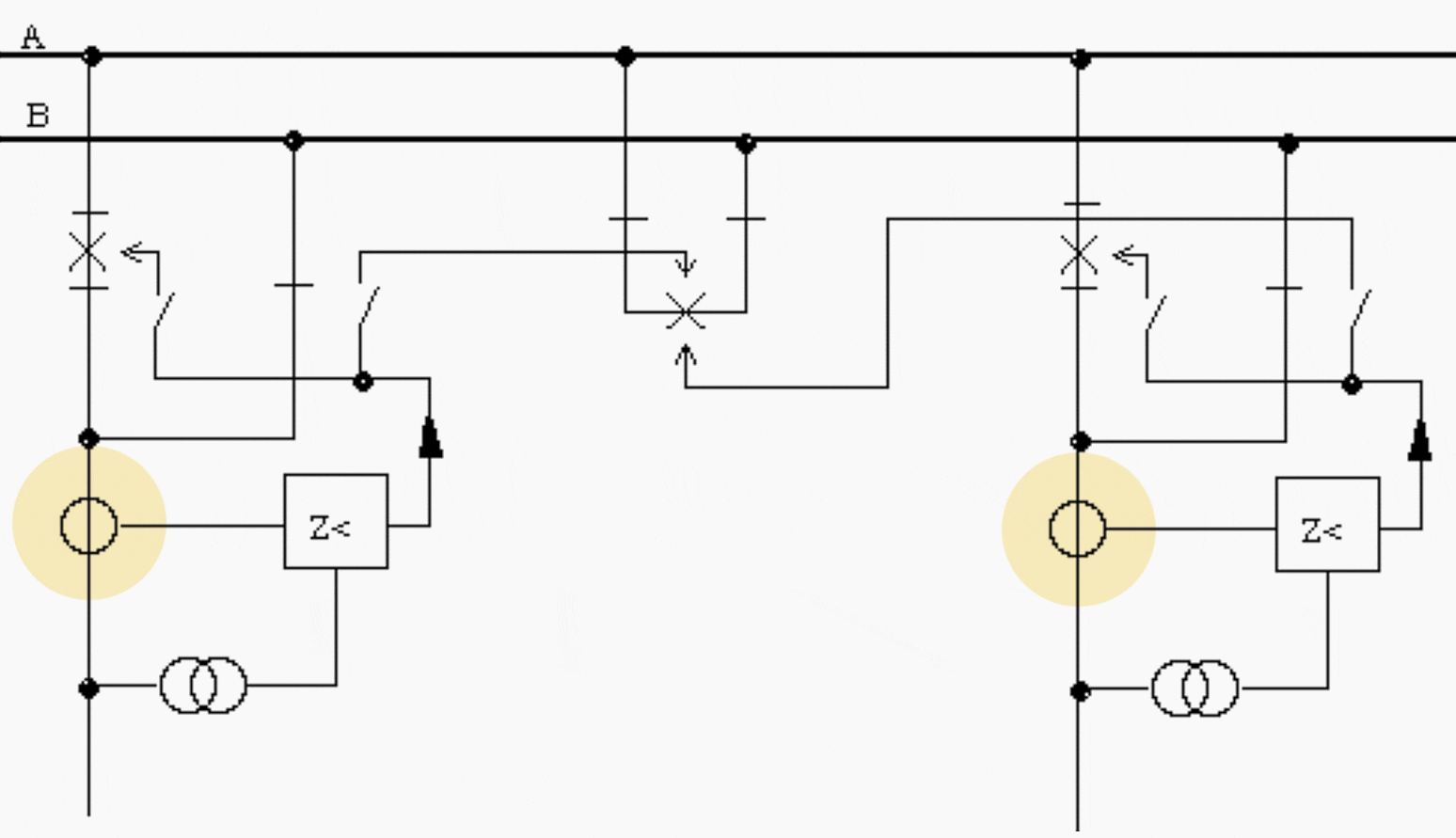

At one and a half breaker systems and double breaker systems, the current transformers in the two sections are connected together in a summation. Similar core data on the involved cores will match each other when the cores are summed.
A control of possible primary current loops through the current transformer must be done, when circuit breaker is earthed on both sides. Resistance of primary loop is seen as the current transformer ratio in square times the primary loop resistance from the secondary side.
A fault or load current in the other (summated) current transformer will thus be split up between protection/meters and the primary loop according to the impedances in the two circuits.
For high impedance protection schemes this could be a problem even with not so low CT-ratio and must be checked. (See Figure 2)
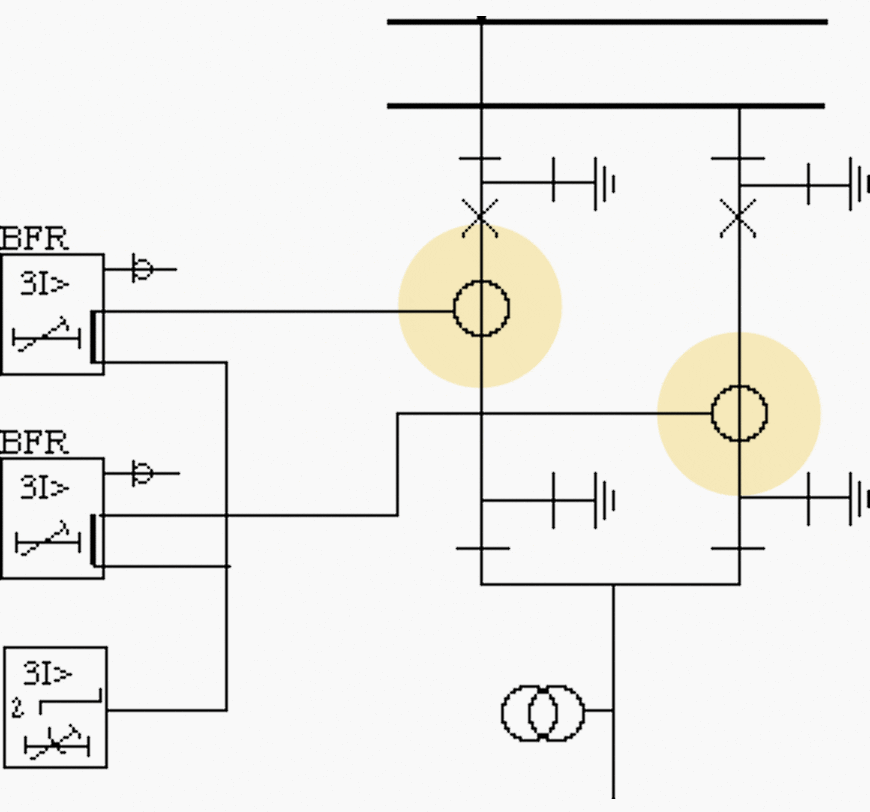

Where: BFR stands for Breaker failure function
1.1.2 Earthing
To prevent dangerous potential in the secondary circuit of a current transformer all secondary circuits shall be earthed. Only one earthing point may be used when several current transformers are connected together in a summation or differential connection.
This is necessary as equalizing currents else can flow through the circuit, during a primary earth fault.
Neutral connection and earthing can be made according to varying practises in different countries and with different utilities. Earthing towards the protected object and neutral connection are the most common principles followed by most companies and manufacturers of protection and metering equipment.
Usually, two principles are followed:
- Neutral and earth towards protected object.
- Neutral and earth toward the metering direction.
1.1.3 Reconnected CT’s
Primary as well as secondary reconnection is used. At primary reconnection there are two primary windings, usually only one turn each, which are connected in series or in parallel. Independent of the connection the same core data will be achieved.
An open current transformer secondary circuit will mean dangerous voltages and must therefor be avoided carefully.
1.1.4 Terminals
To enable a simple testing and reconnection of current circuits at commissioning/fault finding a terminal grouping as in Figure 3 can be used. A simple change of current direction is achieved by changing the link. A simple test of each core can be done from the terminals.
The terminals are openable with links and should be suitable for connection of normal test wires.
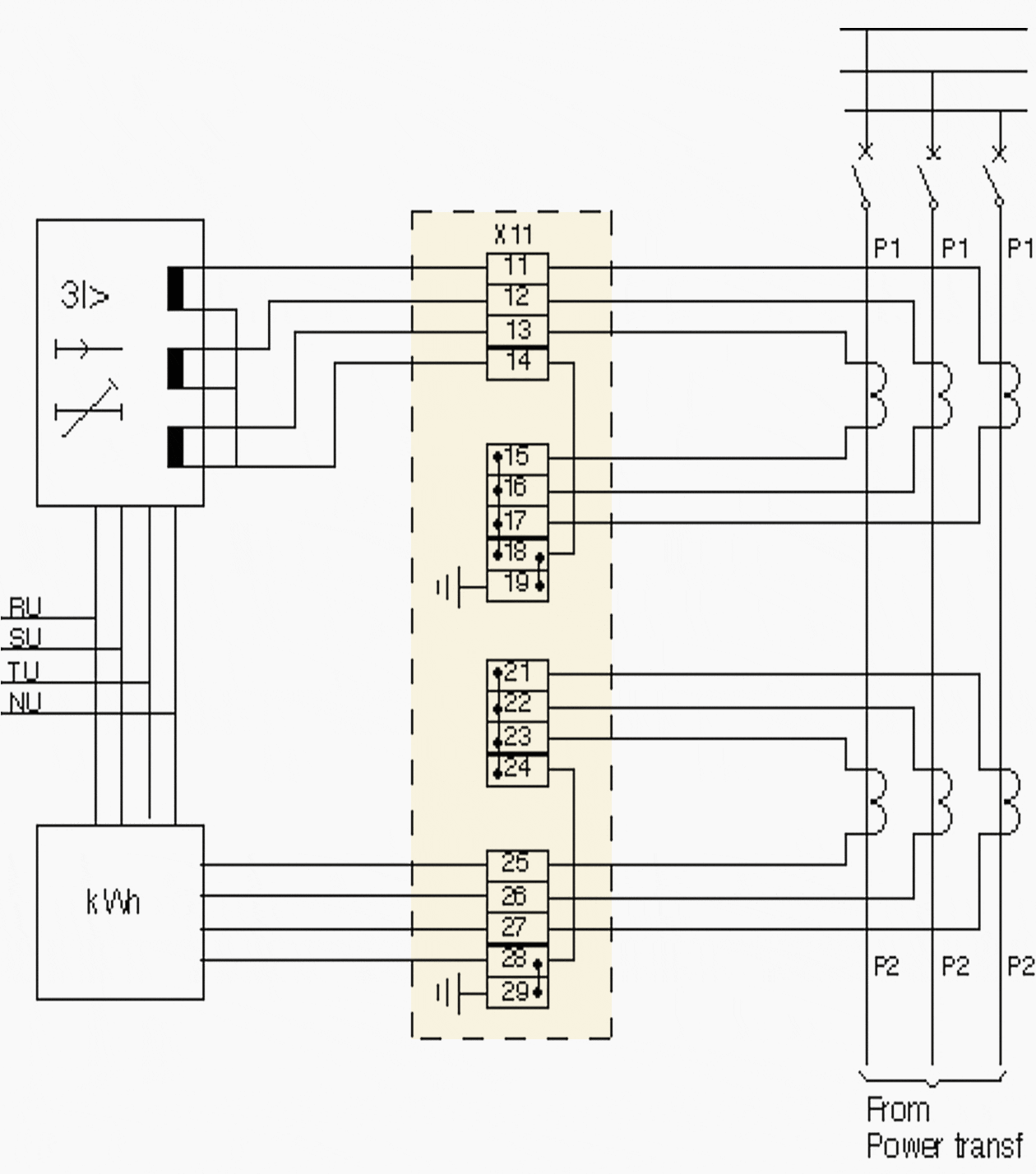

1.2 Voltage Transformers (VTs)
1.2.1 Location of VTs
The location of the voltage transformers will primary depend on the switchgear arrangement, the protection, the metering and the automatics connected. Normally, voltage transformers connected to the busbars and at the low voltage side of the transformers are satisfactory in a distribution substation. Directional protection on outgoing bays are then fed from the busbar VTs.
On the transmission voltage level the protection equipment will normally require voltage transformers at all objects, sometimes with exception of the HV side of power transformers. Further, a single phase set is located at the busbars for voltage, frequency and synchronizing purpose.
This avoids complex voltage selection schemes.
Connection schematics of voltage transformers for protective applications
1.2.2 Earthing and fusing of VTs
The secondary circuits are fused and earthed in the VT marshalling box. This will ensure that dangerous voltages will not occur. Connection of different VT/CVT circuits should therefor be avoided to prevent equalizing currents in the secondary circuits during primary earth faults.
The fusing can be done with diazed fuses or miniature circuit breakers (MCBs). The tripping condition must be checked i.e. it must be checked that the fuses/MCB will trip within a reasonable time (e.g. 5 sec). This normally means that higher rated currents than 6 A cannot be used.
1.2.3 Supervision of VTs
A fault can always occur even if the plant is well designed and well constructed. When a fault occurs it’s of importance that the fault is immediately detected and an alarm given to enable the maintenance personal to quickly repair the fault.
An occurring unsymmetry between the phases will be detected and the relay can by that detect one or two phase fuse failure.
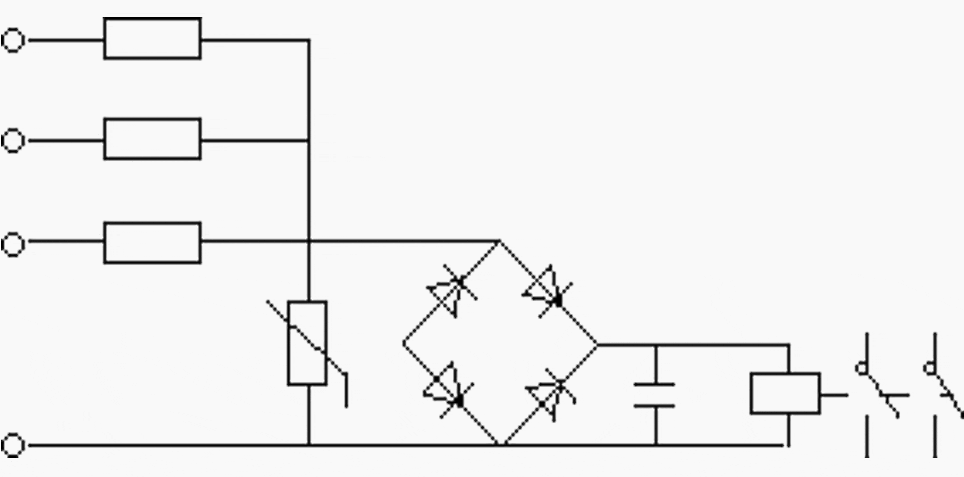

If a protection relay is supplied a supervision according to Figure 5 can be used. A differential voltage measuring is used where the voltage of a main fuse, supplying the protection relay, and a pilot fuse are compared.
This principle will detect one, two or three phase fuse failures.
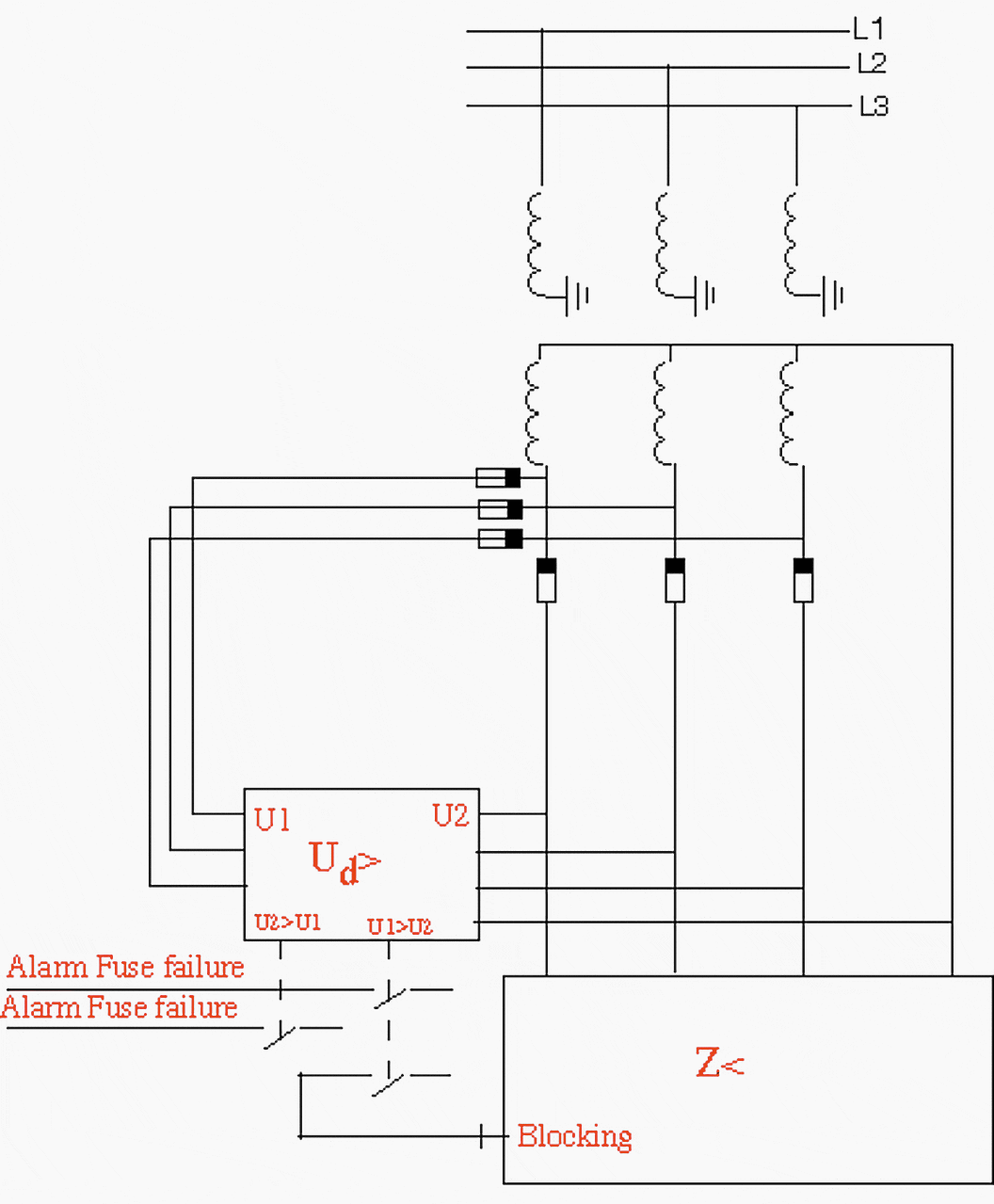

Another solution used to detect fuse failures in some types of Distance protection is to compare the occurrence of zero, or negative, sequence voltage with the occurrence of zero, or negative, sequence current. If only voltage occurs the problem is a blown fuse. If both current and voltages occur there isn’t a fuse problem but a primary earth fault.
If MCBs are used an auxiliary contact can be used to give alarm. If Distance protection relays shall be blocked a special MCB with low instantaneous level and a very fast auxiliary contact must be used.
1.2.4 Cabling of VTs
Dedicated cables shall be used for the voltage transformer secondary circuits. The cable shall be screened and earthed at both ends to keep the disturbance voltages to low levels.
The secondary cabling must be dimensioned to:
- Ensure that fuse/MCB will operate, in a reasonable time, for a fault at the far end of the cables.
- Keep the voltage drop, due to the burden, one level lower than the inaccuracies in the voltage transformer.
A special problem occurring in voltage transformer circuits if fuses are used is the risk of back-feeding a faulty phase from the healthy phases. This phenomena occurs when phase to phase connected load exists. The phase with the blown fuse can reach rather high voltage level. The level is decided by the load in the different phases as indicated in Figure 6.


1.3 Auxiliary Power Distribution
The auxiliary power system has a very central role in a substation. A fault in the battery system will mean that neither control and protection equipment nor primary equipment can fulfil their tasks. Often a complete station or a big part of a station is influence by a main problem in the auxiliary power system.
At higher system voltages, two battery systems are mostly provided to feed the local back-up protection, in redundant protection systems. At lower voltages this is not necessary as a protection system with remote back-up normally is used. This means that faults can be detected from another location as well.
The secured feeding of alarm circuits for DC problems must be ensured. A well designed supervision of the DC supply to an object should supervise the feeding fuse, an open circuit and a blown fuse/MCB in the sub-distribution.
An example of a DC supervision is shown in Figure 7. It’s often a good idea to include the contacts of the DC/DC converters in the different protection relays in the supervision, so that a common alarm is given when DC problems anywhere in the distribution occurs.
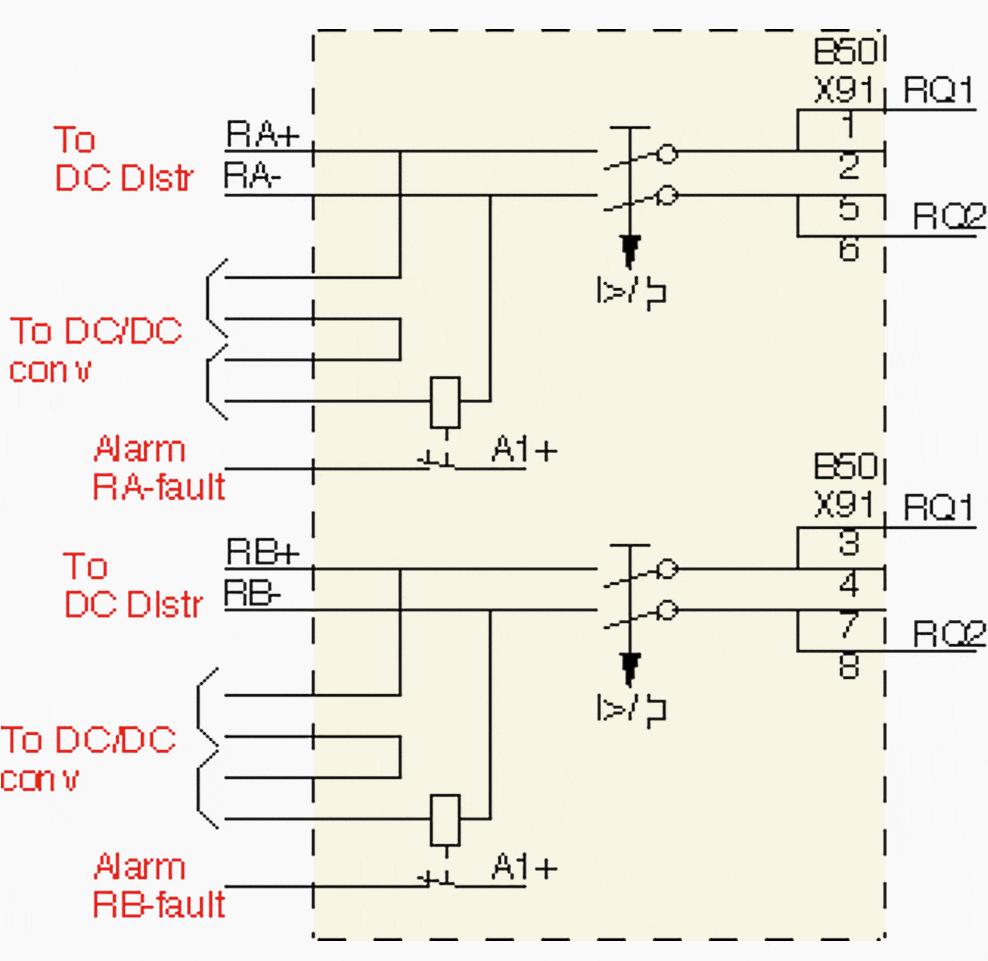

1.4 Supply of different equipment
Varying principles are used in the auxiliary power supply of the equipment. An important principle is to limit the distribution of the auxiliary power supply to the protection system as much as possible, and to use only one supply to the protection of an object and the breaker trip coil.
To simplify the fault finding at earth faults in the DC supply system a structured terminal system as shown in Figure 8 can be useful.
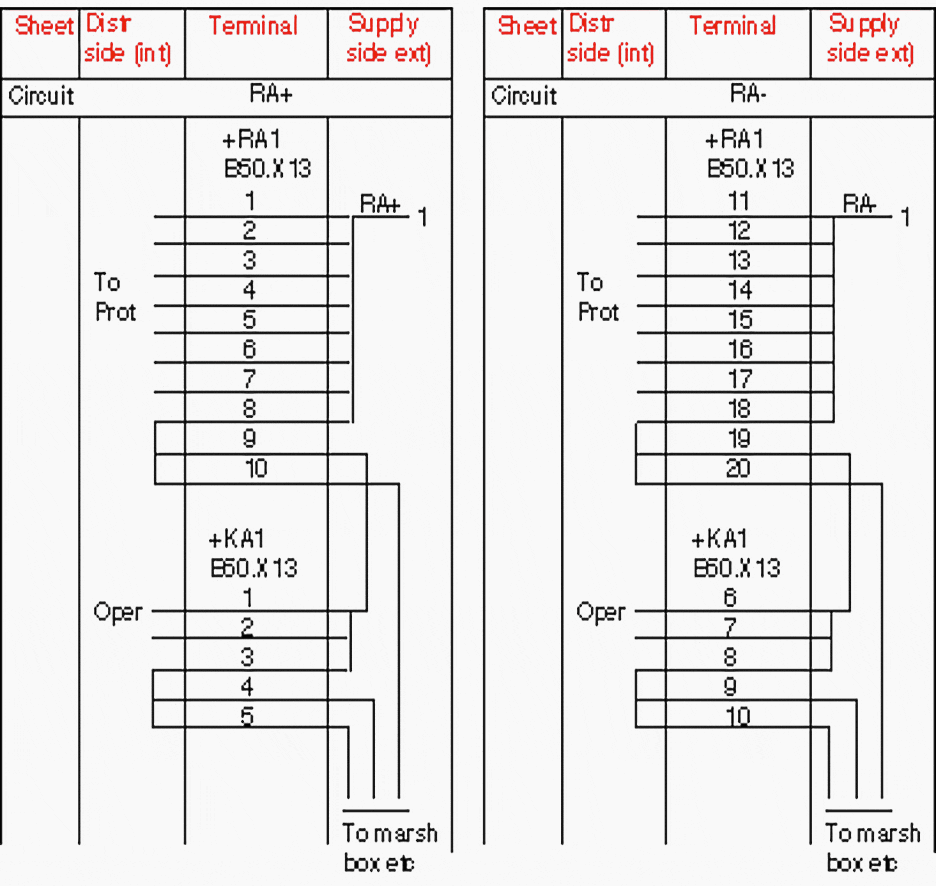

The system includes a supply of marshalling boxes, control panels (and other panels) and internal distribution from different terminals, so that each circuit simply can be opened and checked for e. g. bad insulation. The terminal numbering system utilized is described later on.
To enable location of an earth fault, in a operation circuit, at a disconnector/earthing switch, with two pole operation, a resistor shall be connected across the contact at the negative side.
2. Protection and Control Equipment
2.1 Design of Protection Panels
The panel design and construction shall be done following a number of general guidelines:
- The layout are to follow the layout of the primary switchgear to avoid confusion.
- The panels should be clearly and visible labelled, so that objects located in the panel is simply identified.
- The possibilities of future extensions should be kept in mind both in panel design and the location in the room etc.
- Maintenance should be simplified as much as possible and the design should minimize the risk of mistakes such as testing the wrong object or the need of making a lot of reconnections, to enable testing.
- Two object per panel, should be avoided but must be done out of cost reason. The belongings of the object shall then clearly be labelled both on front and inside the panel.
2.1.1 Terminals
The terminals are small but important components in a substation. They should have possibility to simple connect and disconnect measuring wires with a clearly visible indication. A maximum of two cores are to be connected at each side of the terminal and a mixture of single core and stranded wires should be avoided.
The system used enables a clear separation of main and back-up protection and gives an indication of interface and trip circuits which is of importance for the service and maintenance. The system is also made for connection of cables. Cable cores are simple to erect as the connection of the different cores is in the same group.
Extra terminals for future use can also simply be added with a prepared and correct number.
Eight common mistakes in reading and creating single line and wiring diagrams
2.1.2 Trip circuit design
The trip circuits are together with the DC supply key parts of the fault clearance chain. Trip circuit supervision can be used to improve the dependability of the circuit. The circuit from the relay panel to the circuit breaker, including the auxiliary contact of the breaker is supervised by a small current (1-20 mA), fed through the circuit.
Through a special circuit, with a resistor and an auxiliary contact at the breaker, the circuit can be supervised also when the breaker is open. A double supervision where a current measuring relay is connected both in the breaker circuit and across the relay can be used when lock-out trip relays are used.
The arrangement of a trip circuit supervision is shown in Figure 9.
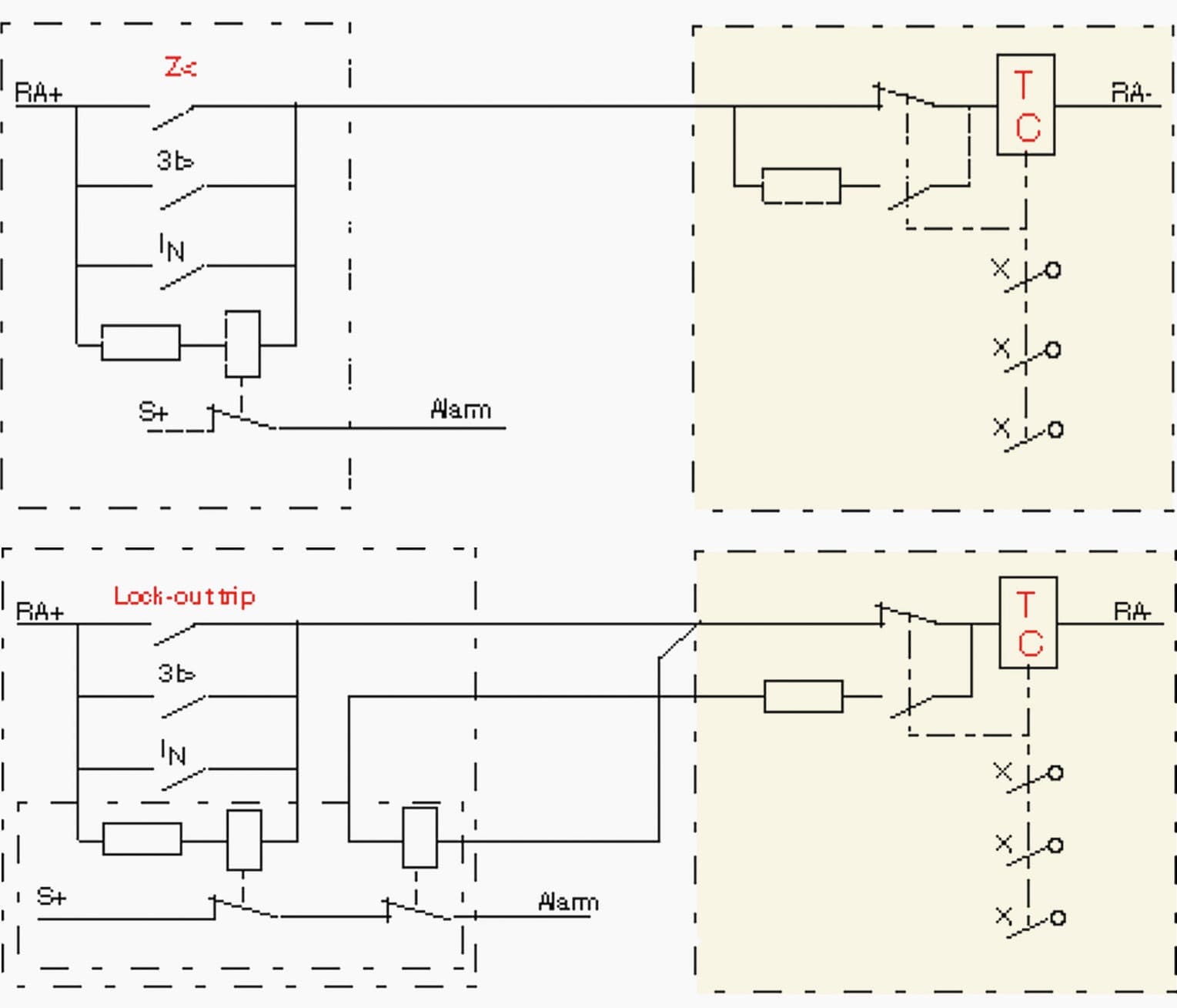

The trip coils of the circuit breaker normally have a power need of 200-300W. A common requirement is that the contacts of the trip relays are capable of breaking the current to the trip coils even though there is an auxiliary contact in the breaker doing this.
This contact will however not operate at a breaker failure and heavy duty contacts are therefor advantageous.
2.1.3 Busbar protection trip circuits
Trip arrangements for busbar protection relays can be done in different ways. The bus-principle as shown in Figure 10 is preferred, as it gives a simple and clear technical solution, where Breaker failure trip simple can be arranged to trip the busbar, without need of extra auxiliary contact on the disconnectors.
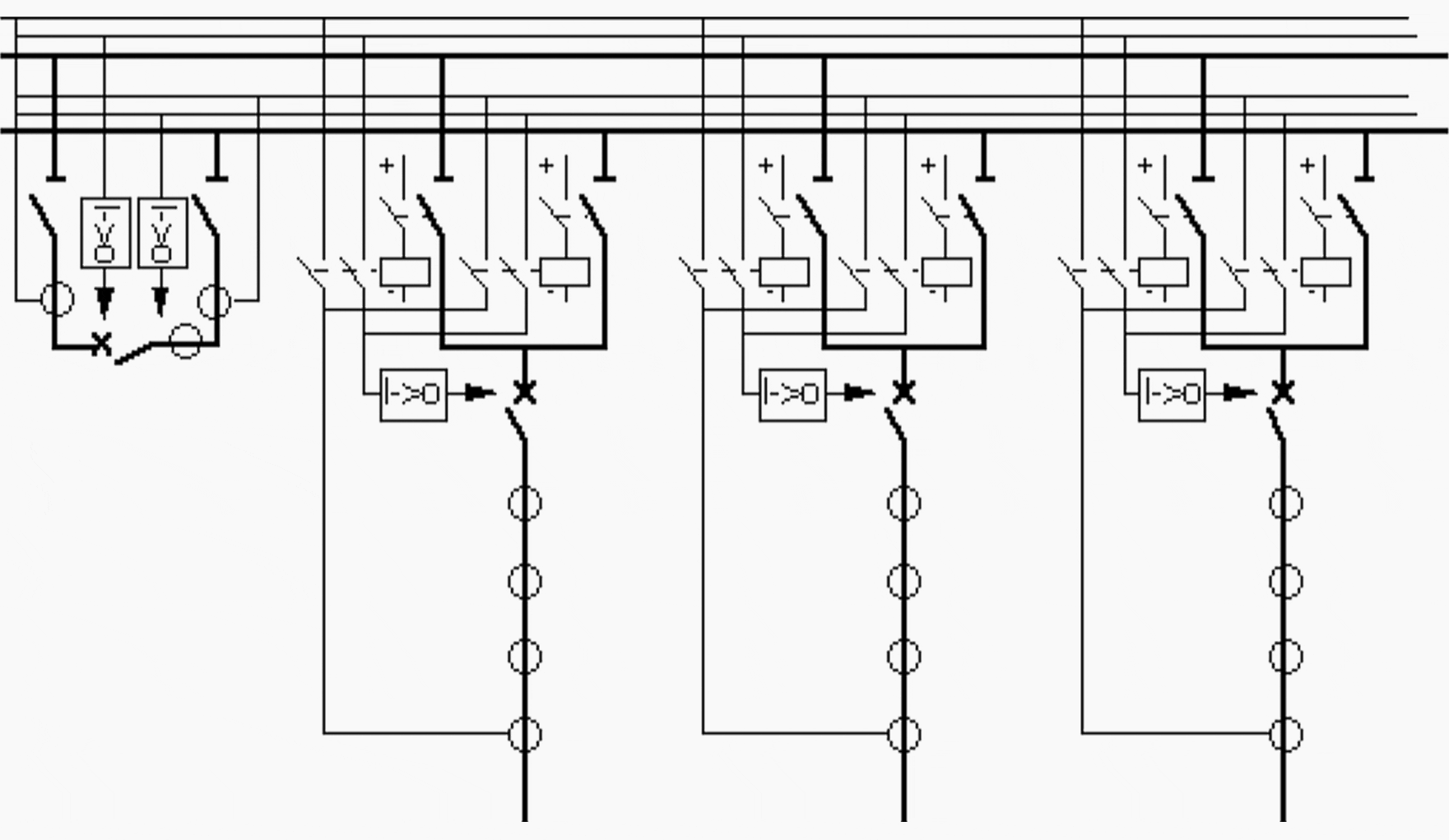

2.1.4 Lock out tripping
Lock-out of circuit breaker closing should be initiated from protection relays covering faults of permanent type. Lock-out relays are reset manually, when the fault has been repaired. The best solution is to open the close circuit only. A permanent signal in the trip circuit only isn’t good as the breaker then can be unnecessary initiated even though instantaneously retripped.
A continuous trip will also mean problems for trip circuit supervision and special care need to be taken for this.
Lock-out should thus preferable be performed with self reset trip relays and latching relays opening the closing circuit only.
2.1.5 Capacitive discharges
Trip and important operation relays should be stable during the capacitive discharges which can occur at an earth fault in the DC system. The problem is shown in Figure 11.
Special types of relays with a stabilization against this discharge are available.
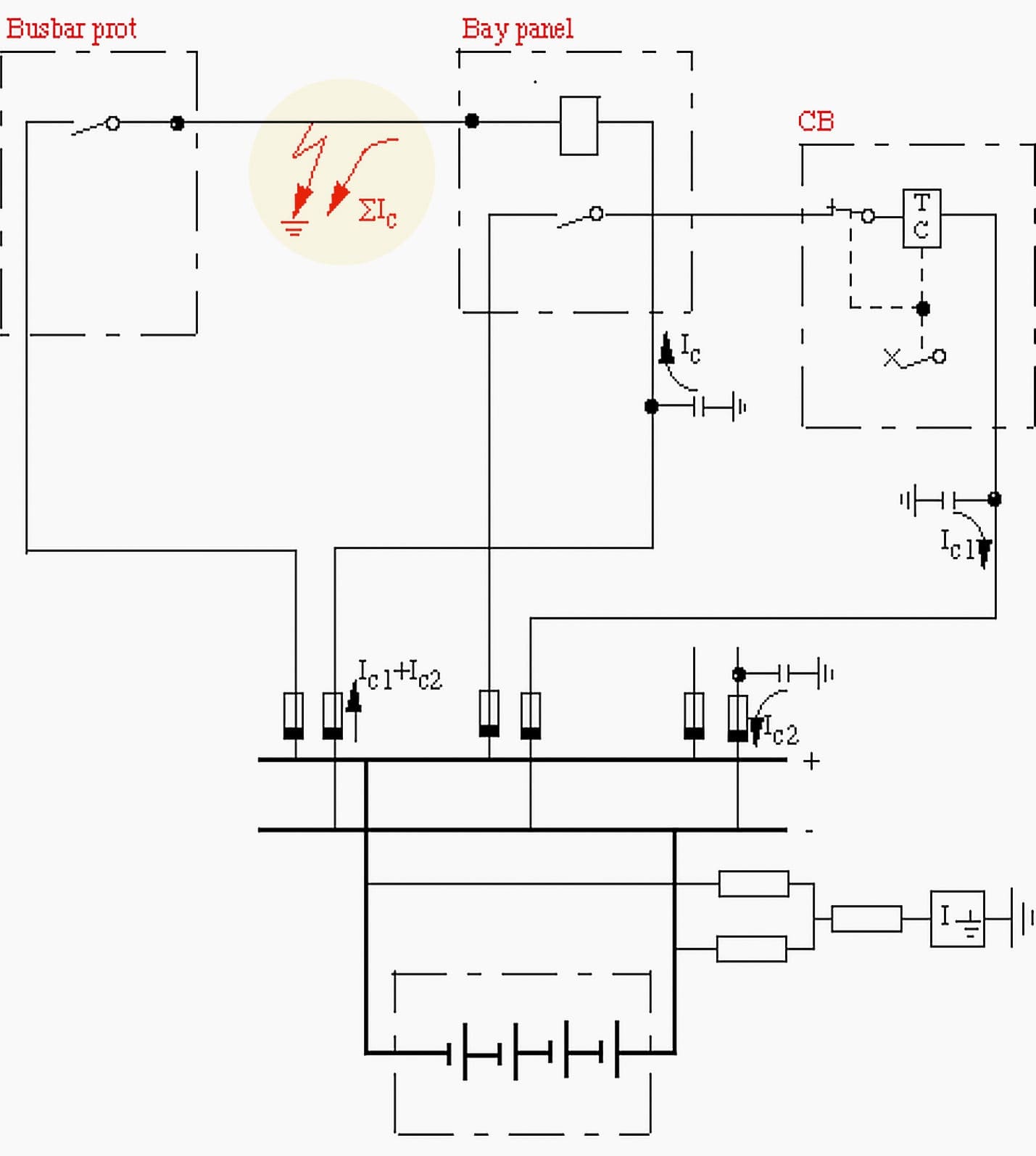

3. Signalling
3.1 Fault Signalling
At a fault in the primary network it’s of importance that the operating personal receives information about fault type, whether the fault is persistent or transient, what phases are involved and the fault location so that correct actions can be taken.
At a fault in a the protection and control equipment it’s of great importance that the operating personal receives information about the disturbances so that corrective actions can be taken. These faults don’t normally mean disturbance for the system service but need to be repaired within a short time.
Several different equipment types are used to give information about primary and control equipment faults. Among them you’ll find:
- Annunciator system
- Event recorder
- Disturbance recorder
- SCADA
One important part in order to achieve a high reliability and in order to follow up disturbances in the primary system and the behavior of the protection system is the post fault analysis.
3.2 Annunciator System
The annunciator system will give the operating personal quick information about a fault. At activation of an alarm point an audible alarm is initiated. This alarm is locally switched off when the station is remotely controlled.
All faults are to be alarmed but grouping in suitable groups is done to save cost and to simplify for the operator as too much information will only be confusing when a quick decision have to be taken.
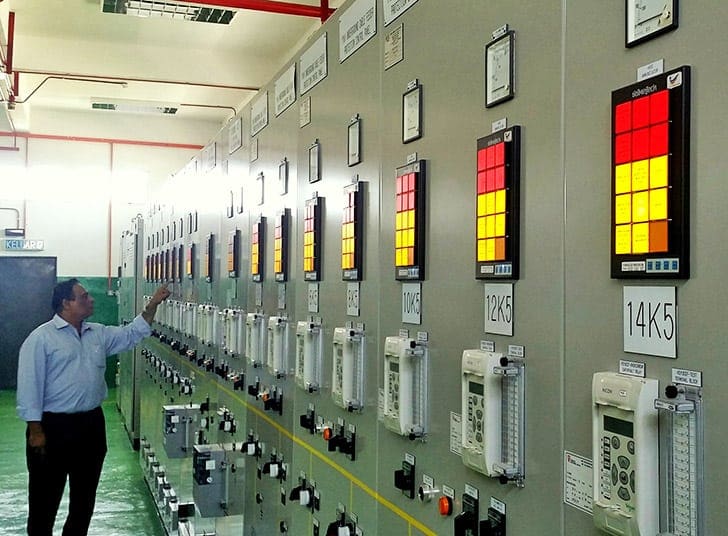

3.3 Event Recorder
The event recorders gives digital, time tagged, information about all disturbances in the control system, as well as in the primary system. The sequence of events such as starting of measuring zones and phase selection etc., can be followed with a resolution of some ms which simplifies the follow up on a disturbance.
This follow up is performed later by experts at protection and control systems. Information at the event recorder is just to a low extent used by
the operators.
3.4 Disturbance Recorder
The disturbance recorder gives information about the analogue signals during a primary fault. A few digital event are also connected to get a time reference and a possibility to compare the event recorder and disturbance recorders information. The disturbance recorder starts when any protection relay starts or trips. A pre-fault memory is included.
The recording will thereby include information from just before the fault (0.1-0.5 seconds) to up to after the fault has been cleared.
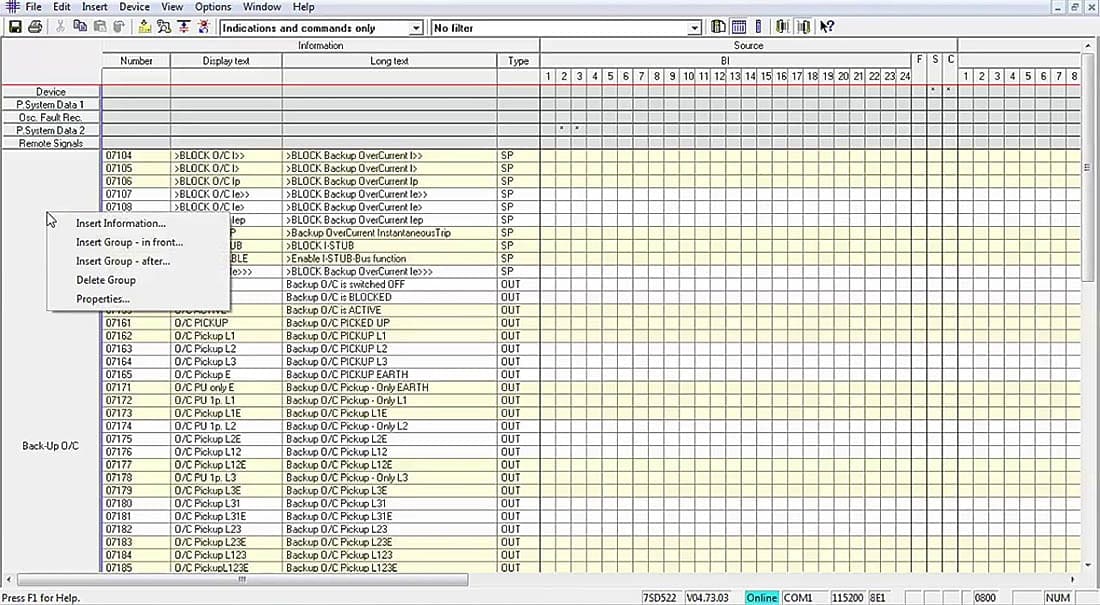

3.5 Remote Signalling
Most stations in the world, are today remotely controlled, or prepared for remote control. Locally available signals must be transmitted with high reliability to the dispatch center and to the operators.
This concerns signals for faults in the primary system, as well as faults secondary in the control system.
Source: Protection application by ABB








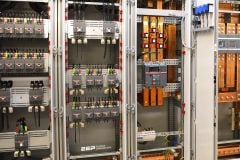

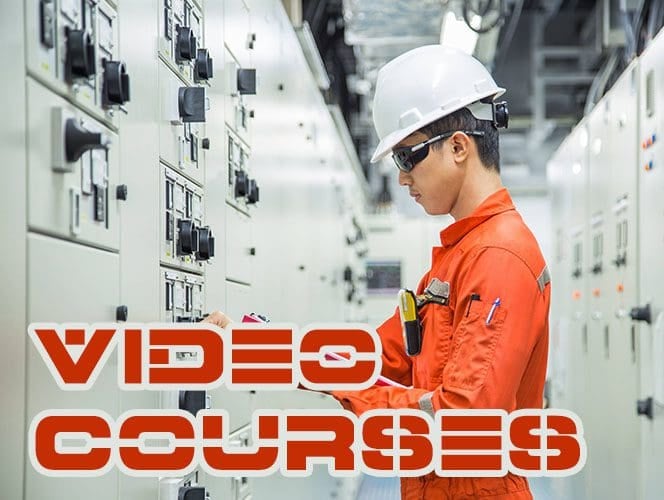
Good work. Thanks
transformer base earthing how is it done.
muchas gracias …muy buena la informacion , los temas son excelentes
diariamente lo estoy revisando y estudiando
Dear Sir,
Is it recommended to install the remote control panel (mimic) in the same room as the 11kV switchgear? Are there any international standards?
Nice article. This helps me a lot to understand the transmission of electricity. Thanks for the info.
i want to greatly increase my expertise but I do not hold any job currently plus I am 54years old. how can you help me?
I am thinking about Scada system,The communicating of signals